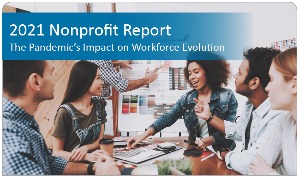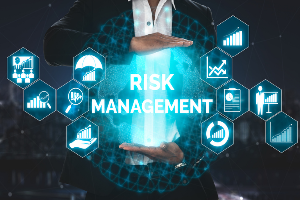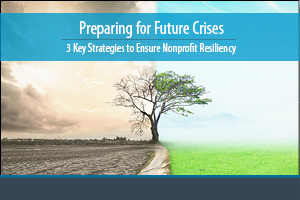
Nonprofit employers nationwide are living through a fundamental transformation in the way they work and the pace at which employee priorities are changing. In the latest rendition of UST Live, we were joined by leaders from across the U.S with expertise in nonprofit management to discuss innovative strategies for creating a forward-looking workplace culture that is flexible, inclusive, and resilient.
Watch now to discover:
Upcoming UST Live Webinars: UST Live was designed to equip nonprofit leaders with strategies that can help sustain their workforce and their mission-driven initiatives. In our final session of the year—scheduled for early December—we’ll discuss nonprofit leadership and succession planning.

Are you curious to discover how nonprofits have pivoted strategies in response to COVID-19 and how this pandemic is causing permanent change across the sector? With over 400 survey respondents—representing a wide variety of nonprofits from across the U.S.—this report unveils the pandemic’s impact on workforce evolution and illustrates how the sector withstood the hardships caused by the crisis.
Download the report to learn:
This report will provide valuable insight on how nonprofit organizations are navigating the ongoing challenges that have arisen throughout the pandemic. For only $99, download your copy of the 2021 sector report today!

Risk management is defined as a discipline for dealing with the possibility that some future event will cause harm and nonprofit risk comes in an endless number of forms—data security, fundraising fraud, regulatory compliance, employee relations, volunteer staff, and theft just to name a few. Given the myriad of ways that nonprofits are changing the world and the impossible task of being able to predict every potential mission-disrupting event, every organization stands to benefit from risk reducing tactics. This is where risk management comes in—an essential necessity that helps nonprofits understand the threats they face and how to prioritize strategies that create sustainability in the future.
Developing a risk management process is essential to every nonprofit but many remain unprotected simply because they don’t have the funds or resources to implement such a strategy. There are however other ways to protect your organization without breaking the bank that just require more time and dedication to create and streamline. So, if you don’t have a risk management strategy in place already, now is the time to start.
Follow these four steps to create a risk management strategy:
A single liability incident can easily cost tens of thousands of dollars, not to mention the harm it can do to your reputation. In short, by taking the time to identify risks, prioritize issues, respond to the problems, assess the situation, and improve your strategy, nonprofit employers can better protect their assets and avoid future risks.

UST just released the latest edition of our Quarterly Nonprofit Digest. This quick reference guide highlights key findings from last quarter’s most popular content—which focused on innovative nonprofit sustainability strategies to help employers thrive in these ever evolving times.
If you’re a nonprofit leader, download your free copy of the Q2 quarterly digest to discover essential strategies for:
You’ll also gain access to helpful checklists, people risk management templates and best practice tips to help you plan (and execute) a successful virtual event.
To get more nonprofit-exclusive content, webinar invitations and sector insights delivered straight to your inbox, sign up for UST’s eNewsletter today.

UST recently published an eBook that discusses how the global pandemic challenged nonprofits in ways that were unprecedented at that time and how taking the time to develop better defenses against subsequent crises—building greater resilience against natural, economic and health threats—nonprofits can move toward a better prepared future.
This insightful eBook uncovers strategies that can help nonprofits implement a game plan that will help ensure organizational sustainability in the wake of the next disaster. Available now for download, UST’s eBook will help you protect your employees, continuity of services and the communities you serve when future challenges arise.
In this eBook, you’ll also discover:
Don’t miss your opportunity to download your complimentary copy of “Preparing for Future Crises: Strategies to Ensure Nonprofit Resiliency” to discover how to protect your nonprofit and its workforce from future crises.

In the latest rendition of UST Live, we were joined by guest moderator, Jenny Berg of the Leadership Council for Nonprofits, where we welcomed thought leaders from across the U.S. with expertise in DEI best practices. In this session, the panel discussed innovative strategies for identifying (and prioritizing) board diversity and inclusion practices—that in turn can help advance your mission in such a way that is both equitable and more appealing to donors, potential job candidates and the communities you serve.
Watch now to discover:
Upcoming UST Live Webinars: This webinar series was designed to equip nonprofits with the strategies and resources they need to survive (and thrive) in a constantly evolving environment. Be on the lookout for our next UST Live sessions—scheduled for June, September, and December—where we’ll discuss strategies surrounding nonprofit sustainability, HR and compliance and leadership development.

With the rise of smartphones, social media and other digital channels, nonprofits now have more tools available to them for engaging donors than ever before. The issue that comes with having so many ways to donate, is that it can be difficult to pinpoint which engagement techniques are most effective for engaging donors. Most nonprofits know that the main form of donor engagement is making a donation, however, there are quite a few ways to engage with those individuals any time they support or directly interact with the organization. Any opportunity to interact with a donor is a chance to strengthen your relationship with them, which could naturally result in more donations.
To show appreciation for your donors, it’s crucial to develop nonprofit donor engagement strategies that strengthen the relationship between you and your supporters. If you’re looking for best practices to boost your donor engagement, here are four key techniques that can help your nonprofit raise more money and improve your donor retention rate:
1) Create Personal and Genuine Messaging: Engaging your donors requires a personal and authentic approach. Take the time to learn about your donor’s interests as individuals and be transparent when you have interactions with them. Establishing trust with your donors will often result in their willingness to support your mission and reaching your donors on a more personal level, can allow for more opportunities to create personalized engagement strategies down the line.
2) Utilize the Benefits of Software: It’s a challenging task to keep up with hundreds, thousands, or even tens of thousands of donors. Successful communication with your donors requires individualized approaches and the information necessary to make it possible to make those individualized approaches come to life. This is where having a donor database can be a great resource—a nonprofit CRM—a tool built to help nonprofits track all aspects of their donor relationships.
3) Offer and Implement a Membership Program: A membership involves the donor giving fees or dues to a nonprofit in exchange for member status and the rights, perks or benefits that are included in the membership. The frequency and type of engagement opportunities you offer members will depend on your organization, but the possibilities can be endless. For example: host member only events, special volunteer opportunities or a member ONLY newsletter.
4) Create a Text Communication Option: Seeing as texting is such a prevalent communication method, organizations need to take advantage of this huge engagement opportunity. There are many services that enable nonprofits to establish a text marketing list, allowing your organization the ability to send a mass text message to all donors who subscribed to this list.
Looking for opportunities to engage with your donors authentically and honestly will go a long way in ensuring donors donate time and time again. Take the time to deeply understand why the donor supports you and deliver on their expectations. Start seeing a donation as a part of a relationship, not a one-off business transaction. This way you begin to deepen relationships with people that support what you do, rather than just treating them as just donors. Show gratitude to your donors, invite them to engage in other ways than donating, share with them why they matter, and get to know them on a more personal level.

Nonprofits across the country were forced to pause, pivot and make remarkable changes to their in-person events last year due to the unprecedented circumstances of COVID-19. As organizations continue thinking about their in-person vs. virtual strategies, the hybrid future of events is taking form—changing the events landscape for years to come.
Virtual events offer the best combination of brand exposure and the digital engagement people crave. Whether your event is large or small, one day or one week, we’ve compiled some of the top Virtual Event Best Practice Tips to help you navigate the many considerations involved in planning (and executing) a successful virtual event.
Want access to more nonprofit-specific tips, toolkits and webinars? Sign up for our nonprofit eNewsletter today!

In today’s talent-based economy, an organization’s workforce is one of its most important tangible assets. Despite its importance, this asset is often not carefully planned, measured, or optimized. This can mean that many organizations are not sufficiently aware of the current or future workforce gaps that will limit execution of the current business strategy. Yet at the same time, boards of directors, CEOs and chief human resource officers will frequently declare that workforce planning and data-driven decision making is a top priority for their organizations.
While there can be a disconnect in understanding why there is a gap between intent and execution, the most obvious cause is a lack of defining consistent objectives regarding the outputs of workforce planning, and a lack of consistent processes by which organizations conduct workforce planning and future modeling. Organizations need to design an approach that moves workforce planning from only being considered by a small group of those who think about the future of their workforce, to everyone looking at it’s overall operational effectiveness—this is where management is accustomed to spending its time and energy.
When creating a workforce strategy, there are five key workforce areas that are critical to driving successful business outcomes:
1) Defining Business Operations and Direction: The most critical step in strategic workforce planning is alignment—alignment of business strategy, organizational structure, people, and results. Ensure clarity around strategic objectives, then make sure you have a holistic organizational design and talent plan to drive getting the right people with the right skill set into the right role, thus delivering results.
2) Staffing & Talent Goals: Strategic workforce planning is a key component when looking at the overall talent strategy. It begins with understanding where the organization is headed; what are the future organizational capabilities? This helps the organization identify new skills and competencies needed to create learning and developing opportunities. This is turn, helps define the talent acquisition strategy.
3) Training & Innovation: Offering training opportunities is an ideal way to retain your current staff and to bring on new talent. Investing in developing your employee’s skill set, knowledge and experience will go a long way in nurturing an employee’s journey while encouraging innovation within your workforce.
4) Employee Feedback: Taking the time to listen to your employees is key when creating a successful workforce strategy. Not only can showing your workforce that you are really listening to them improve employee engagement levels, but it also can boost workplace morale, job satisfaction rates and overall retention. Taking the employee feedback and applying it to the development of your workforce strategy will result in a more cohesive and successful strategy.
5) Workplace Environment: Factoring in the importance of your organization’s work environment from an overall workforce strategy perspective can enable an uptick in performance by increasing innovation, employee experience and most importantly, productivity.
Workforce planning requires in-depth insight into what a company needs in terms of talent and skills. And breaking it down into these five key areas will allow your organization to develop and sustain high quality workforce planning programs and be rid of the traditional barriers that can restrain effective workforce planning.

This year, UST has been busy creating a plethora of timely and relevant resources designed specifically to help the nonprofit sector navigate the many unknowns presented by the pandemic. You probably recall seeing some of these resources over the past eight months but… with everything you are dealing with these days, you may have missed something.
Below is a list of our Top 5 Resources from 2020:
As nonprofit employers and their employees continue to adjust their processes for how they work, UST remains committed to supporting the sector with reliable resources that help manage the day-to-day operational challenges. Interested to see what other content we have? Visit our Content Library today!

UST maintains a secure site. This means that information we obtain from you in the process of enrolling is protected and cannot be viewed by others. Information about your agency is provided to our various service providers once you enroll in UST for the purpose of providing you with the best possible service. Your information will never be sold or rented to other entities that are not affiliated with UST. Agencies that are actively enrolled in UST are listed for review by other agencies, UST’s sponsors and potential participants, but no information specific to your agency can be reviewed by anyone not affiliated with UST and not otherwise engaged in providing services to you except as required by law or valid legal process.
Your use of this site and the provision of basic information constitute your consent for UST to use the information supplied.
UST may collect generic information about overall website traffic, and use other analytical information and tools to help us improve our website and provide the best possible information and service. As you browse UST’s website, cookies may also be placed on your computer so that we can better understand what information our visitors are most interested in, and to help direct you to other relevant information. These cookies do not collect personal information such as your name, email, postal address or phone number. To opt out of some of these cookies, click here. If you are a Twitter user, and prefer not to have Twitter ad content tailored to you, learn more here.
Further, our website may contain links to other sites. Anytime you connect to another website, their respective privacy policy will apply and UST is not responsible for the privacy practices of others.
This Privacy Policy and the Terms of Use for our site is subject to change.
UST maintains a secure site. This means that information we obtain from you in the process of enrolling is protected and cannot be viewed by others. Information about your agency is provided to our various service providers once you enroll in UST for the purpose of providing you with the best possible service. Your information will never be sold or rented to other entities that are not affiliated with UST. Agencies that are actively enrolled in UST are listed for review by other agencies, UST’s sponsors and potential participants, but no information specific to your agency can be reviewed by anyone not affiliated with UST and not otherwise engaged in providing services to you except as required by law or valid legal process.
Your use of this site and the provision of basic information constitute your consent for UST to use the information supplied.
UST may collect generic information about overall website traffic, and use other analytical information and tools to help us improve our website and provide the best possible information and service. As you browse UST’s website, cookies may also be placed on your computer so that we can better understand what information our visitors are most interested in, and to help direct you to other relevant information. These cookies do not collect personal information such as your name, email, postal address or phone number. To opt out of some of these cookies, click here. If you are a Twitter user, and prefer not to have Twitter ad content tailored to you, learn more here.
Further, our website may contain links to other sites. Anytime you connect to another website, their respective privacy policy will apply and UST is not responsible for the privacy practices of others.
This Privacy Policy and the Terms of Use for our site is subject to change.